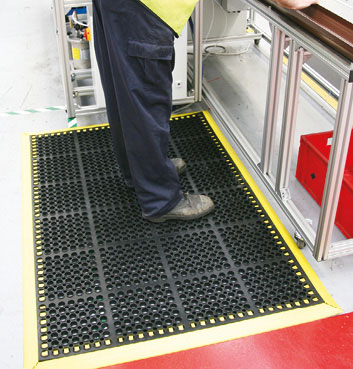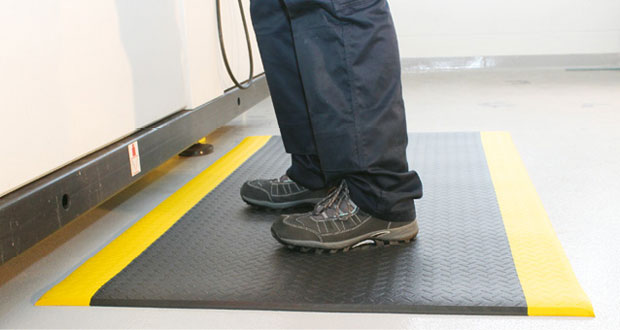Richard O’Connor from First Mats explains why standing too long causes more than just sore feet, and how Anti-Fatigue Mats work to alleviate the problem
If you’re one of the 11 million people in the UK(i) who spend most of their working day on their feet, you’ll be all too familiar with the aches and pains standing can cause. Extended periods of standing increases pressure on joints and muscles, eventually causing Musculoskeletal Conditions (MSDs), affecting over 470,000 people in the UK. These pains, combined with reduced blood circulation, lead to feelings of fatigue, reducing wellbeing and productivity.
Anti-fatigue mats address this issue by inducing micro-movements in leg muscles through their cushioned surface, promoting blood flow and reducing muscle stiffness. The cushioning nature of these mats relieves pressure on the knees and back and creates a slight instability that prompts the leg muscles to adjust constantly. This continuous adjustment is crucial for blood circulation, as the leg muscle contractions pump blood back to the heart. When standing still, the calf muscles do not contract and relax as they do during walking, leading to blood pooling in the lower limbs, and consequently causing discomfort and fatigue.
Additionally, the cushioning effect of anti-fatigue mats leads to natural, frequent changes in standing position, ensuring even weight distribution between both feet, improving posture and minimising joint and muscle pain. Furthermore, the soft surface of anti-fatigue mats presents a warmer alternative to cold hard floors. A cold floor can lower body temperature, making the heart work harder to maintain warmth.
Anti-Fatigue Mat Studies,(ii) including one conducted at the Center for Ergonomics at the University of Michigan, validate their efficiency. This study, in particular, concluded that workers who used anti-fatigue mats reduced their fatigue and discomfort by up to 50 per cent.
Material selection is an essential aspect of anti-fatigue mats. Natural rubber, vinyl, PVC, polyurethane, and foam are common materials. Foam-based mats are ideal for dry areas and light to medium-duty applications. Rubber mats are recommended for areas with heavy machinery. Vinyl-topped mats, which consist of a foam centre and a vinyl surface, are also suitable for heavy-duty areas.
 While one might assume that thicker mats are more effective, this is not always true. An optimal balance between softness and stability is necessary. The commonly used 9mm thickness is suitable for medium-duty and continuous-use applications. Heavy-duty applications may require thicknesses ranging from 10mm to 14mm.
While one might assume that thicker mats are more effective, this is not always true. An optimal balance between softness and stability is necessary. The commonly used 9mm thickness is suitable for medium-duty and continuous-use applications. Heavy-duty applications may require thicknesses ranging from 10mm to 14mm.
Studies have also shown that businesses using anti-fatigue mats report improved productivity and staff wellbeing while reducing absenteeism. For this reason, anti-fatigue mats should be seen as an investment for workers who spend most of the working day on their feet.
(i) www.safeworkers.co.uk/health-wellbeing/standing-for-long-periods
(ii) www.firstmats.co.uk/blogs/buying-guides/what-are-anti-fatigue-mats





